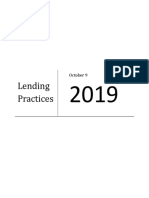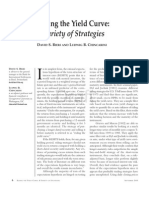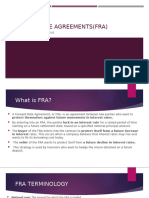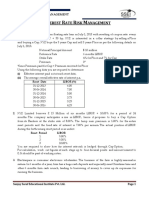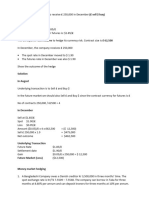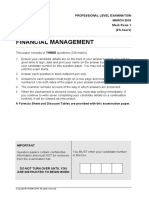3 Forward Rate Agreements and Interest Rate Swaps: B. A. Eales, Financial Engineering © Brian Eales 2000
3 Forward Rate Agreements and Interest Rate Swaps: B. A. Eales, Financial Engineering © Brian Eales 2000
Uploaded by
Thao NguyenCopyright:
Available Formats
3 Forward Rate Agreements and Interest Rate Swaps: B. A. Eales, Financial Engineering © Brian Eales 2000
3 Forward Rate Agreements and Interest Rate Swaps: B. A. Eales, Financial Engineering © Brian Eales 2000
Uploaded by
Thao NguyenOriginal Title
Copyright
Available Formats
Share this document
Did you find this document useful?
Is this content inappropriate?
Copyright:
Available Formats
3 Forward Rate Agreements and Interest Rate Swaps: B. A. Eales, Financial Engineering © Brian Eales 2000
3 Forward Rate Agreements and Interest Rate Swaps: B. A. Eales, Financial Engineering © Brian Eales 2000
Uploaded by
Thao NguyenCopyright:
Available Formats
3 Forward Rate Agreements and
Interest Rate Swaps
Swaps in all but name have been around for many years. Originally conceived to
help stabilise currencies and facilitate financial activities between governments as
long ago as the 1920s, they have, in recent years, developed beyond recognition
from their forerunners and now play a major global role in corporate sector
financing. Although swaps basically fall into two main categories, interest rate and
currency swaps, within these categories there are many divisions, subcategories,
refinements and derivatives. The market for swaps is global, enormous and highly
liquid; every major financial institution has its swap book which will be passed
from centre to centre as trading closes in one market and opens in another elsewhere
in the world.
This chapter and the next will examine the calculation and uses of interest rate
and currency forwards. In addition Synthetic Agreements for Forward Exchange
(SAFEs), interest rate swaps, the mechanics of their operation, and their advantages
and disadvantages will be examined. These chapters will also consider special types
of swaps, discuss their application, and demonstrate how such instruments operate
in practice and how they might be hedged should the need arise. A more recent
instrument- equity swaps- will be covered in Chapter 5.
3.1 FORWARD INTEREST RATE AGREEMENTS (FRAS)
Having been used for many years in commodity and financial markets as risk
management or hedging instruments, forward contracts have a long, well-established
pedigree. The contracts themselves are very simple. In general they represent an
agreement between two parties (usually two financial institutions or an institution
and a corporate client) to undertake a transaction at some agreed future date at a
price agreed now. The party agreeing to buy at the future date is said to be taking
a long position. The counterparty agreeing to make delivery at the future date is
said to be taking a short position.
The idea of a short interest rate position was illustrated in Figure 2.4 in Chapter
2. The price which appears in the contract is termed the delivery price and delivery
will take place on the settlement day based on a reference rate determined on the
fixing date some days earlier than the settlement date. 1 Benchmarks for short-term,
interbank interest rates are provided by many newspapers as well as specialist data
vendors such as Datastream, Bloomberg, Reuters, etc. The quotes show a bid-offer
78
B. A. Eales, Financial Engineering
© Brian Eales 2000
Forward Rate Agreements and Interest Rate Swaps 79
spread, for example 6!4-6. This spread indicates the rate at which the bank will lend
money (6!4%) and the rate the bank will pay on deposits (6% ). To avoid unnecessary
complication mid-rates will be used in the examples throughout this text.
The idea behind the calculation of forward rates is not complicated. Take the
scenario where an investor has a sum of money to invest for up to a period of 6
months. There are two strategies open to the investor: the principal can either be
deposited with a bank for the full 6 months or it can be invested for a period of 3
months and then reinvested at the end of 3 months, together with the interest which
has accrued, for a second 3-month period. The reinvestment rate at the end of the
third month, which ensures the investor's indifference between the two strategies,
is the forward rate.
It would at this point be useful to compare how the use of short-term interest
rate forwards differs from their exchange-based futures contract counterparts.
Returning to the interest rate example discussed in Chapter 2 will provide a useful
vehicle to achieve this end.
Example 2.1 revisited
Assume that the current interbank offer rate for 3-month money is 6.00%, and that
this is the index on which the company's loan payments are based. Assume further
that the rate for 6-month money is 6.125%. Armed with this information it becomes
possible to calculate an implied 3-month rate that would take effect from the end
of the third month and hold for a further 3-month period.
Calculation of a benchmark for this forward rate can be achieved by using
quoted spot rates on the basis of the following formula:
The 0.5 and 0.25 terms indicate the 3- and 6-month investment horizons and the
rij terms the spot or implied forward interest rates. By inserting the known 3- and
6-month spot rates it becomes clear that the only unknown in the equation is the
r 36 . Rearranging equation (3.1) yields:
r36 -r(1+(6~~~5}(o.s)) 1 I · 4 = 0.061576 (3.1')
(1 +(:~}(o.25))
in other words an implied forward rate of approximately 6.16%.
You might also like
- ACI Dealing Certificate Study GuideDocument156 pagesACI Dealing Certificate Study GuidehangobazuluNo ratings yet
- ACCA Financial Management - Mock Exam 1 - 1000225 PDFDocument25 pagesACCA Financial Management - Mock Exam 1 - 1000225 PDFrash D100% (1)
- CH 09Document34 pagesCH 09Khoirunnisa Dwiastuti100% (3)
- SWIFT Message Support in T24Document24 pagesSWIFT Message Support in T24babasakthiNo ratings yet
- CH 09Document34 pagesCH 09Azhar SeptariNo ratings yet
- Fabozzi Fofmi4 Ch11 ImDocument12 pagesFabozzi Fofmi4 Ch11 ImYasir ArafatNo ratings yet
- Bond Portfolio Management StrategiesDocument11 pagesBond Portfolio Management StrategiesDimple Sutaria100% (1)
- Financial Risk Management: A Simple IntroductionFrom EverandFinancial Risk Management: A Simple IntroductionRating: 4.5 out of 5 stars4.5/5 (7)
- Eun8e CH 011 TomDocument33 pagesEun8e CH 011 TomCarter JayanNo ratings yet
- Swap Rate PaperDocument50 pagesSwap Rate PaperAshwin R JohnNo ratings yet
- The Valuation of Floating Rate Instruments Theory and EvidenceDocument22 pagesThe Valuation of Floating Rate Instruments Theory and EvidenceZhang PeilinNo ratings yet
- Private Equity Hong Kong InsightsDocument4 pagesPrivate Equity Hong Kong InsightseezmathNo ratings yet
- Damodaran Chapter 4 WACCDocument5 pagesDamodaran Chapter 4 WACCJesus LuisNo ratings yet
- An Introduction To SwapsDocument5 pagesAn Introduction To SwapsShamshadAliNo ratings yet
- The Structure of Interest Rates (Note)Document18 pagesThe Structure of Interest Rates (Note)Hoi Mun100% (1)
- Chapter 9 - Interest Rate and Currency Swaps (Q&A)Document5 pagesChapter 9 - Interest Rate and Currency Swaps (Q&A)Nuraisyahnadhirah MohamadtaibNo ratings yet
- ÔN TẬPDocument5 pagesÔN TẬPThuy TranNo ratings yet
- Interest Rate Parity, Money Market Basis Swaps, and Cross-Currency Basis SwapsDocument14 pagesInterest Rate Parity, Money Market Basis Swaps, and Cross-Currency Basis Swapsultr4l0rd100% (1)
- Interest Rate Parity, Money Market Basis Swaps, and Cross-Currency Basis SwapsDocument14 pagesInterest Rate Parity, Money Market Basis Swaps, and Cross-Currency Basis SwapsReema RatheeNo ratings yet
- Forward Rate Agreement CalculationDocument4 pagesForward Rate Agreement Calculationjustinmark99No ratings yet
- FIMA Act. 2Document2 pagesFIMA Act. 2Donnathel BetangcorNo ratings yet
- Documentos de Trabajo: Universidad Del Cema Buenos Aires ArgentinaDocument26 pagesDocumentos de Trabajo: Universidad Del Cema Buenos Aires Argentinaserafo147No ratings yet
- 15. Use of Derivative to Hedge Against Interest Rate RiskDocument12 pages15. Use of Derivative to Hedge Against Interest Rate RiskhapfyNo ratings yet
- GW JEL DraftDocument65 pagesGW JEL DraftFirman Aditya BaskoroNo ratings yet
- OTS Prepay and Valuing Individual Mortgage Servicing Contracts - A Comparison Between Adjust Rate Mortgages and Fixed Rate MortgagesDocument16 pagesOTS Prepay and Valuing Individual Mortgage Servicing Contracts - A Comparison Between Adjust Rate Mortgages and Fixed Rate MortgagesfhdeutschmannNo ratings yet
- Activity#2Document9 pagesActivity#2Hagad, Angelica BA 2ANo ratings yet
- Term Structure of Interest RatesDocument15 pagesTerm Structure of Interest Ratesabdulraqeeb alareqiNo ratings yet
- Term Premia: Models and Some Stylised FactsDocument13 pagesTerm Premia: Models and Some Stylised FactssdafwetNo ratings yet
- FRADocument4 pagesFRASeema SrivastavaNo ratings yet
- Research Paper On Term Structure of Interest RatesDocument7 pagesResearch Paper On Term Structure of Interest RatesafdtrzkhwNo ratings yet
- Type The Document TitleDocument18 pagesType The Document TitleAnonymous zXwP003No ratings yet
- 807512Document24 pages807512Shweta SrivastavaNo ratings yet
- What Is The Capital Asset Pricing ModelDocument10 pagesWhat Is The Capital Asset Pricing ModelshlakaNo ratings yet
- Libor Market Model Specification and CalibrationDocument29 pagesLibor Market Model Specification and CalibrationGeorge LiuNo ratings yet
- 23 Valuing DebtDocument14 pages23 Valuing Debtddrechsler9No ratings yet
- Riding The Yield Curve Variety of StrategiesDocument30 pagesRiding The Yield Curve Variety of Strategieshrm_mircNo ratings yet
- Shapiro Chapter Solutions ch09Document10 pagesShapiro Chapter Solutions ch09Kelvin ChenNo ratings yet
- (Lehman Brothers, Tuckman) Interest Rate Parity, Money Market Baisis Swaps, and Cross-Currency Basis SwapsDocument14 pages(Lehman Brothers, Tuckman) Interest Rate Parity, Money Market Baisis Swaps, and Cross-Currency Basis SwapsJonathan Ching100% (1)
- Interest Rate FuturesDocument19 pagesInterest Rate FuturesJimit ShahNo ratings yet
- Capitulo 5Document30 pagesCapitulo 5Daniel Adrián Avilés VélezNo ratings yet
- Fixed Income and Credit Risk v3Document27 pagesFixed Income and Credit Risk v3FNo ratings yet
- Literature Review On Interest Rate ChangesDocument4 pagesLiterature Review On Interest Rate Changesea8m12sm100% (1)
- Dyn Prog Ace MortgageDocument12 pagesDyn Prog Ace MortgagebsaikrishnaNo ratings yet
- EM4001Ch6 Gearing and Cost of CapitalDocument42 pagesEM4001Ch6 Gearing and Cost of CapitalGabriel OkuyemiNo ratings yet
- Investments Chapter 11Document32 pagesInvestments Chapter 11m.shehrooz23No ratings yet
- IF Unit 5Document7 pagesIF Unit 5Pratheek GowdaNo ratings yet
- FIN204 AnswersDocument9 pagesFIN204 Answerssiddhant jainNo ratings yet
- Financial Management: Chapter Three Time Value of MoneyDocument16 pagesFinancial Management: Chapter Three Time Value of MoneyLydiaNo ratings yet
- Yield CurveDocument7 pagesYield CurveromanaNo ratings yet
- Duration PDFDocument8 pagesDuration PDFMohammad Khaled Saifullah CdcsNo ratings yet
- Interest Rate Swaps M An Agency Theqretic Model M Pnterest RatesDocument10 pagesInterest Rate Swaps M An Agency Theqretic Model M Pnterest RateserererehgjdsassdfNo ratings yet
- SwapsDocument17 pagesSwapsBruno André NunesNo ratings yet
- KupnovDocument20 pagesKupnovkurdiausha29No ratings yet
- Predictive Power of YIeld CurveDocument24 pagesPredictive Power of YIeld CurveRavi KumarNo ratings yet
- Chapter 6 Solution Manual For Principles of Managerial Finance 13th Edition Lawrence PDFDocument24 pagesChapter 6 Solution Manual For Principles of Managerial Finance 13th Edition Lawrence PDFNazar FaridNo ratings yet
- FRAs - Hedging, Speculation, ArbitrageDocument59 pagesFRAs - Hedging, Speculation, Arbitragebajajvanshika14No ratings yet
- Fair Valuation of Residential Whole Loans: Jay Guo, PH.D Interactive Data Corporation May 2011Document4 pagesFair Valuation of Residential Whole Loans: Jay Guo, PH.D Interactive Data Corporation May 2011bigposerNo ratings yet
- Fixed Income Quant: Strategies for Modeling Bonds and Interest RatesFrom EverandFixed Income Quant: Strategies for Modeling Bonds and Interest RatesNo ratings yet
- Exchange Rate Determination Puzzle: Long Run Behavior and Short Run DynamicsFrom EverandExchange Rate Determination Puzzle: Long Run Behavior and Short Run DynamicsNo ratings yet
- Financial Plans for Successful Wealth Management In Retirement: An Easy Guide to Selecting Portfolio Withdrawal StrategiesFrom EverandFinancial Plans for Successful Wealth Management In Retirement: An Easy Guide to Selecting Portfolio Withdrawal StrategiesNo ratings yet
- Asset and Liability Management for Banks and Insurance CompaniesFrom EverandAsset and Liability Management for Banks and Insurance CompaniesNo ratings yet
- Investment Analysis and Portfolio Management - (Part 2 Developments in Investment Theory)Document38 pagesInvestment Analysis and Portfolio Management - (Part 2 Developments in Investment Theory)Thao NguyenNo ratings yet
- 1 s2.0 S0261560622000791 MainDocument21 pages1 s2.0 S0261560622000791 MainThao NguyenNo ratings yet
- The Annexation of Crimea Through Game THDocument11 pagesThe Annexation of Crimea Through Game THThao NguyenNo ratings yet
- Geographical Analysis - January 1984 - Ghosh - A Location Allocation Model For Facility Planning in A CompetitiveDocument13 pagesGeographical Analysis - January 1984 - Ghosh - A Location Allocation Model For Facility Planning in A CompetitiveThao NguyenNo ratings yet
- Forward Rate AgreementsDocument4 pagesForward Rate Agreementskhuluma SinginiNo ratings yet
- International Finance Final Exam Study GuideDocument23 pagesInternational Finance Final Exam Study GuideOscar WongNo ratings yet
- Interest Rate Risk Management PDFDocument2 pagesInterest Rate Risk Management PDFHARSHALRAVALNo ratings yet
- Forward Forward 13TH November 2020Document12 pagesForward Forward 13TH November 2020Jovan SsenkandwaNo ratings yet
- International Banking and Money MarketDocument28 pagesInternational Banking and Money MarketNiharika Satyadev JaiswalNo ratings yet
- Trial Examination FM JJ2022Document15 pagesTrial Examination FM JJ20222017963155No ratings yet
- Sample Exam - FIN30014 - SolutionDocument11 pagesSample Exam - FIN30014 - SolutionJason DanielNo ratings yet
- Single-Period Binomial HeathDocument7 pagesSingle-Period Binomial HeathmuhammadhasjmyNo ratings yet
- Trading and Hedging STIR 010218Document4 pagesTrading and Hedging STIR 010218Yashas IndalkarNo ratings yet
- Practice Questions 3Document1 pagePractice Questions 3yichan0519No ratings yet
- FIM Math NotesDocument34 pagesFIM Math NotesbaomihvNo ratings yet
- Question Paper Financial Risk Management - II (232) : April 2006Document16 pagesQuestion Paper Financial Risk Management - II (232) : April 2006api-27548664100% (2)
- Managing Currency RisksDocument28 pagesManaging Currency Risksarif nizamNo ratings yet
- 5 Basic Products (1204)Document38 pages5 Basic Products (1204)Luca DiboNo ratings yet
- Fixed Income Markets (Overview)Document21 pagesFixed Income Markets (Overview)VishalMehrotraNo ratings yet
- 5138 5604 Chapter 04 Forward ContractsDocument33 pages5138 5604 Chapter 04 Forward ContractsShomodip DeyNo ratings yet
- FRA ExamDocument6 pagesFRA ExamShubham KumarNo ratings yet
- Ch-11d-Irs, Caps, Floor, FraDocument26 pagesCh-11d-Irs, Caps, Floor, Frashankar k.c.No ratings yet
- QuestionsDocument9 pagesQuestionsShaheer BaigNo ratings yet
- Corporate Treasury Risk Management - Cheat SheetDocument14 pagesCorporate Treasury Risk Management - Cheat SheetHicham NassitNo ratings yet
- SFM Theory Notes - Addendum - Nov 20 To Dec 21 - New Ques - Bhavik ChokshiDocument32 pagesSFM Theory Notes - Addendum - Nov 20 To Dec 21 - New Ques - Bhavik ChokshiAswaniNo ratings yet
- Chapter 5: INTEREST RATE Derivatives: Forwards and SwapsDocument69 pagesChapter 5: INTEREST RATE Derivatives: Forwards and SwapsDarshan rao100% (1)
- 2021CFA二级衍生产品 基础班Document139 pages2021CFA二级衍生产品 基础班CHAN StephenieNo ratings yet
- ICAEW Financial ManagementDocument12 pagesICAEW Financial Managementcima2k15No ratings yet
- Shapiro Chapter Solutions ch09Document10 pagesShapiro Chapter Solutions ch09Kelvin ChenNo ratings yet
- 6249Instant Access to The Financial Times Handbook of Financial Engineering Using Derivatives to Manage Risk Financial Times Series 3rd Edition Lawrence Galitz ebook Full ChaptersDocument55 pages6249Instant Access to The Financial Times Handbook of Financial Engineering Using Derivatives to Manage Risk Financial Times Series 3rd Edition Lawrence Galitz ebook Full Chapterskubatwilgaty100% (1)






























